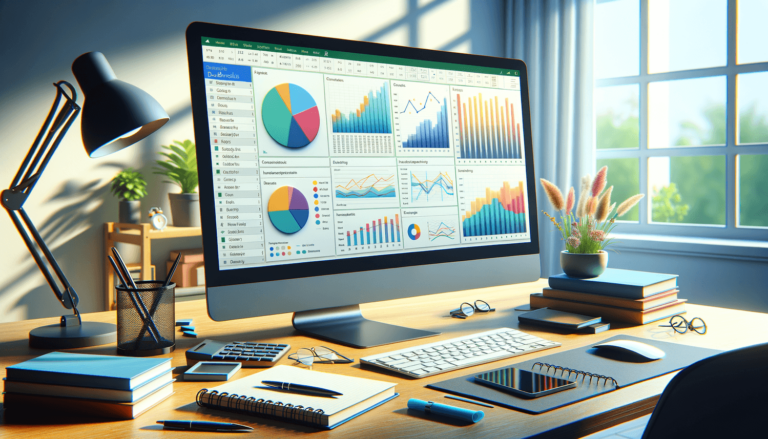

Excel dashboards allow you to collect and analyze complex data from various sources. As businesses grow, it becomes increasingly important to keep track of key performance indicators (KPIs). Dashboards are ideal tools for monitoring KPIs, tracking progress, and making informed business decisions. If you’re new to Excel and want to create dashboards, read on – this post will cover everything you need to know in order to get started!
Excel dashboards help you visualize data that provides indicators of business performance. With a dashboard, it’s much easier to keep track of progress, identify areas of improvement, and make informed business decisions – all without having to wade through a lot of raw, unfiltered data.
To create a dashboard in Excel, follow these simple steps:
Begin by identifying the types of data you want to include in your dashboard. This could include financial data, sales performance metrics, website traffic data, or really anything that you consider important to your business.
Next, identify the key metrics that you want to monitor. These could include metrics such as sales numbers, revenue, customer churn rates, or anything else that is relevant and measurable.
Organizing your data is important when creating a dashboard. Use a separate tab in Excel to set up a spreadsheet for each data source. For example, if you’re pulling in sales data from your point of sale (POS) system, create a separate tab to dump that data into.
Excel offers a variety of dashboard template options, such as line charts, bar charts, and pie charts. Choose a type of dashboard that best suits your data and the considerations of your stakeholder.
Once you have data organized and dashboard type decided upon, start to create the dashboard. Begin by general layout of the dashboard, design, in terms of color, layout, and font. Group your data into the relevant graphs/charts. Make sure it is possible to comprehend the dashboard with one glance. Consult your team to make sure it meets the needs of various stakeholders.
Before you roll out the dashboard, test it thoroughly and make sure all formulas are working as intended. Ask for feedback from both the people who will use the dashboard, and those whose data the dashboard is presenting. Refine the data and design as appropriate, until you have a well-functioning dashboard that meets the needs of all stakeholders.
Make sure to keep the dashboard up-to-date with all relevant data as it becomes available. Depending on how often the data updates, you may need to perform a manual cut and paste or automate this, to ensure it is always accurate and relevant.
Creating dashboards in Excel can seem complicated, but it becomes easier by following the steps outlined in this post. By setting up your data efficiently, choosing the right chart type, and getting feedback from stakeholders, you can create dazzling dashboards that track your key business metrics and provide insights you can use to make informed decisions.
Here are a few tips that can help you create effective dashboards in Excel:
Here are a few examples of types of dashboards that businesses often find useful:
Financial dashboards typically track performance metrics such as revenue, expenses, or accounts receivable. CFOs, accountants, or other financial professionals can use financial dashboards to identify trends and areas where the company could improve its financial performance.
Sales dashboards often monitor performance metrics such as sales activities, win/loss ratios, sales team performance, or pipeline development. Sales managers or representatives can use this information to monitor progress towards targets, plan for the future, and identify opportunities for process improvement.
HR dashboards may provide insight into employee data such as salaries, benefits, or performance metrics. HR managers may use this data to track hiring trends, monitor employee performance, or identify opportunities to streamline HR processes and save time and resources.
Excel dashboards are an essential tool for businesses of all sizes. By following the steps outlined above, you can create a dashboard that suits your business needs and helps you monitor your KPIs more effectively. With some practice and the right tools, you can create dashboards that present complex information in a visually attractive, easy-to-understand format.
Here are some common questions and answers regarding the creation of dashboards in Excel:
A dashboard is a visual representation of data collected from various sources. It helps in the representation of data in an easily understandable visual format, allowing for quick decision making.
Yes, designing a dashboard in Excel does not require a background in programming. Dashboards can be created using simple tools and techniques, as outlined in our blog post.
Excel provides pre-designed templates for creating dashboards that you can use out-of-the-box or customize to suit your needs. These templates are a good starting point for beginners.
Yes, Excel makes it easy to share dashboards with others. You can save the file and send it via email or share it on cloud storage platforms such as Microsoft Teams, Dropbox, or Google Drive. Sharing the dashboard on cloud storage platforms also allows others to collaborate and work on the same document in real-time.
Yes, many third-party tools and add-ons are available to make dashboard creation in Excel even easier. Some popular options include Power BI, Tableau, and Klipfolio. These tools offer additional functionality and capabilities beyond those provided by Excel natively.
Explore the world of Microsoft PowerPoint with LearnPowerpoint.io, where we provide tailored tutorials and valuable tips to transform your presentation skills and clarify PowerPoint for enthusiasts and professionals alike.

Your ultimate guide to mastering Microsoft Word! Dive into our extensive collection of tutorials and tips designed to make Word simple and effective for users of all skill levels.

Boost your brand's online presence with Resultris Content Marketing Subscriptions. Enjoy high-quality, on-demand content marketing services to grow your business.
